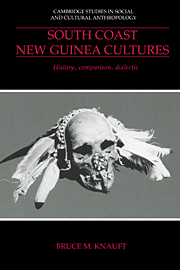Book contents
- Frontmatter
- Contents
- List of figures
- List of tables
- Acknowledgments
- 1 Language-culture areas of south coast New Guinea
- Part 1 Grounding
- Part 2 Critique
- Part 3 Reconfiguration
- 7 Theoretical reconfiguration
- 8 Marind-anim
- 9 Symbolic and sociopolitical permutations
- 10 Regional characteristics and comparisons
- Appendix: evidence concerning Asmat homosexuality
- Notes
- List of references
- Index
- Cambridge Studies in Social and Cultural Anthropology
9 - Symbolic and sociopolitical permutations
from Part 3 - Reconfiguration
Published online by Cambridge University Press: 04 December 2009
- Frontmatter
- Contents
- List of figures
- List of tables
- Acknowledgments
- 1 Language-culture areas of south coast New Guinea
- Part 1 Grounding
- Part 2 Critique
- Part 3 Reconfiguration
- 7 Theoretical reconfiguration
- 8 Marind-anim
- 9 Symbolic and sociopolitical permutations
- 10 Regional characteristics and comparisons
- Appendix: evidence concerning Asmat homosexuality
- Notes
- List of references
- Index
- Cambridge Studies in Social and Cultural Anthropology
Summary
How do Marind-anim compare with the other language-culture areas of south coast New Guinea? To answer this question, we can re-apply the theoretical perspective of chapters 1 and 7 to the other south coast groups. Ethnographically, we can expect to find local permutations on region-wide themes. In a structuralist sense, these permutations are synchronic transformations within a regional cultural structure. But in time, these differences engaged the social and material world to produce surprisingly different results. Structural proliferation is not reversible in practice (Bourdieu 1977, 1990a). The dialectics of practice confront symbolic form with existential result; across space, they actualize social universes that both diverge widely and share much in common.
The Marind-anim ethnography exemplifies a strong relationship between fertility cultism and the patterned spread of ethnic and sociopolitical organization. As other south coast language-culture areas are considered, however, it becomes quickly evident that there was wide variation in the integration versus fragmentation of political units, including their degree of centralization, their practical success in warfare, and their geographic expansion. These intra-regional differences do not correspond in direct fashion to basic contrasts in ecology, subsistence strategy, or social organization. Mythic and ancestral beliefs exerted decisive influence on subjective experience and on both political and ritual action.
- Type
- Chapter
- Information
- South Coast New Guinea CulturesHistory, Comparison, Dialectic, pp. 172 - 209Publisher: Cambridge University PressPrint publication year: 1993



